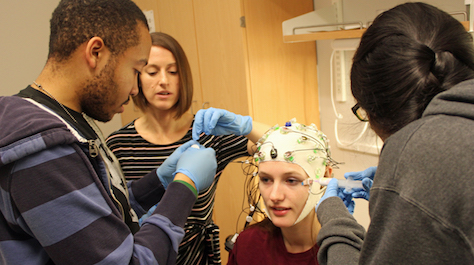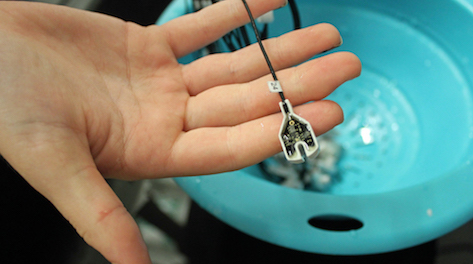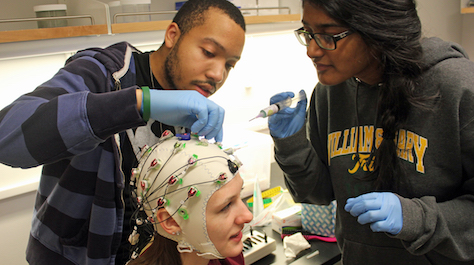It’s Electric
Behind a gray door in the basement of William & Mary’s Integrated Science Center is a narrow hallway that leads to three identical rooms. Each room is furnished with a desk, a chair and a computer monitor.
A lever is bolted to the door of each room. When it closes, the electronic hum of machines, computers and cellphones disappears. The rooms are equipped with copper wiring to minimize interference from any external noise that would disrupt the measurement of electrical signals firing inside the human brain.
The Electroencephalography — or EEG — Lab measures electrical brain activity by employing a series of 32 electrodes placed on a person’s face and scalp. The system monitors the brain’s electrical charge, which is generated by billions of neurons. The lab comes equipped with multiple EEG devices, which can monitor two brains at once.
What happens in the EEG lab is a far cry from the leather couch, a cliché that the Department of Psychological Sciences — and the profession — is actively moving away from.
The department conducts scientific research in which students and faculty collect data, analyze that data and make conclusions. Visitors to the lab are study participants, who help reveal internal processes occurring inside the brain. There is no Freudian daybed on which to divulge their innermost thoughts.
Scientific research plays a key role in the department’s curriculum, and the EEG Lab is an important factor in that research. The system allows researchers to do things like look at brain activity during social interaction.
Merriam-Webster defines psychology as “the science of mind and behavior.” The study of human emotion lies at the intersection of both, which may explain why emotional response is featured in a series of current research projects within the department.
Generating theories and testing those theories are vital skills for anyone looking to enter the field of psychology as a clinician or scientist. Even if a student plans to open their own counseling practice, their time in the lab will inform decisions they make as a practitioner.

















